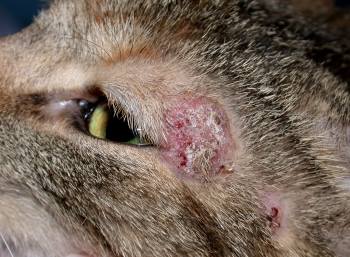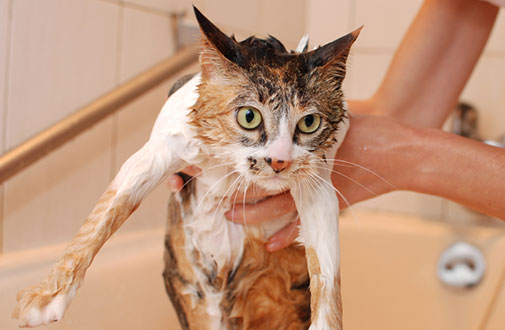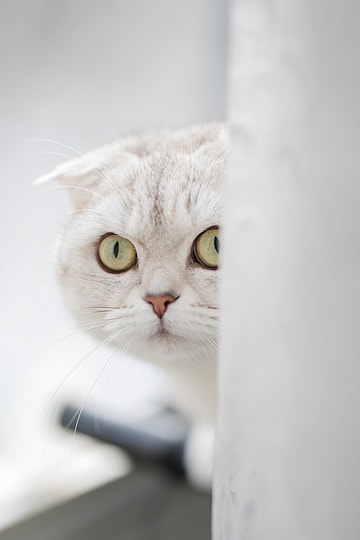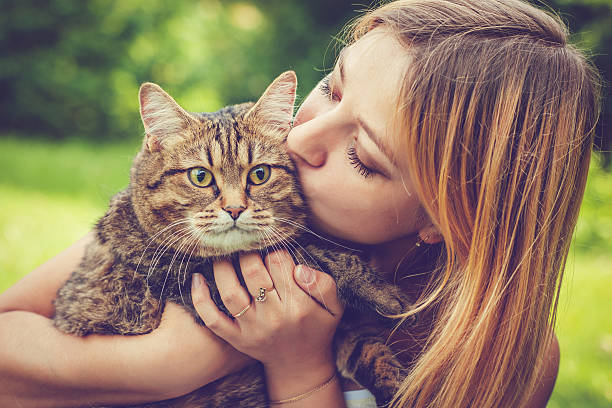While most cats are relatively resistant to infection, there are some diseases that they are more susceptible to than others.
Ringworm is one such disease, and it can be contracted through contact with an infected animal or contaminated surfaces.
The good news is that ringworm is not as contagious as some other diseases, and it can be effectively treated with medication as well as some easy home remedies.
In fact, because ringworm is not fatal, you can easily deal with the infection without needing to go to the vet.
Read on for 15 strategies you can leverage to treat ringworms in your cats at home.
To ensure that you are adequately informed when using any of these strategies, we have also answered some of the popular questions and concerns about ringworms and your cat.
First things first…
How Do You Know If Your Kitty Has Ringworms?

Before you use the remedies or strategies that I have recommended in this post, it is pertinent to be certain that what your cat is dealing with is indeed ringworms.
So, what are some of the symptoms to look for?
Well, it is not always easy to spot ringworms in cats, so you need to pay extra attention.
The only visible indicators that your kitty has ringworms are round thickened patches that expose scaly pink pores.
The most common areas where you are likely to see these patches include your cat’s face, feet, chest, and tail.
But not all cats will manifest this symptom. Other symptoms to look out for include:
- Areas of hair loss with thickened patches
- Inflamed, crusty patches
- Constant scratching or grooming in the same areas
- Ashy dandruff
It is important to note that these symptoms are similar to many other common conditions in cats like mange and allergy dermatitis.
There are also cats, especially the longhaired breeds, which may have ringworms without clear clinical signs or significant hair loss.
So, the only surefire way to confirm whether your cat has ringworms is to make an appointment for an exam with your vet.
Vets do conduct a wide range of tests, including checking for fluorescence with Wood’s lamp, analyzing your cat’s fur under a microscope, or carrying blood tests.
Do I Need To Take My Cat To The Vet For Ringworm?
Ringworm is not a fatal condition, so you don’t really need to take your cat to the vet.
You can easily manage the condition at home until your feline friend recovers fully.
However, if the problem persists, then you should see a vet right away.
The vet will likely prescribe an antifungal medication to treat the infection.
They may also advise you on what you were doing wrong to help you figure out why your remedy didn’t work.
Further Reading: How Much Does It Cost To Treat Ringworm In Cats?
Can Cat Ringworm Heal On Its Own?
While ringworm can be treated with medication, it is also possible for the infection to clear up on its own.
However, this usually takes several months (approximately 9-12 months), and in some cases, the infection may return.
For this reason, it is important to treat your cat not only to ensure they recover quickly but also to prevent it from reoccurring.
Also, if you do not treat it in good time, ringworm can cause serious skin irritation and inflammation.
In severe cases, it can even lead to hair loss and red, scaly patches on the skin.
12 Strategies to Treat Ringworms in Cats without Going to the Vet

There are numerous strategies or home remedies that you can use to treat your kitty’s ringworm. Let’s look at the top 15 most popular options
Antifungal Creams
This is the most common form of treatment for ringworm in cats.
It involves applying an anti-fungal cream or ointment to the affected area daily.
Even though a vet’s prescription is required for some creams, there are several over-the-counter options available.
For best results, go for creams that contain clotrimazole, terbinafine, or miconazole.
Also, be sure to follow the instructions carefully and apply the medication for the recommended period, even if the symptoms seem to have cleared up.
Antifungal Shampoo
There are several anti-fungal shampoos available that can be used to treat ringworm in cats.
These shampoos have active ingredients like miconazole, ketoconazole, or chlorhexidine, which studies have shown, can kill the fungus.
Antifungal shampoos should be used every week, and the affected area should be left covered with the shampoo for at least five minutes before being rinsed off.
Be sure to follow the instructions carefully, as some shampoos are not suitable for use on kittens or cats with certain medical conditions.
Aloe vera
Aloe Vera is one of the most common natural remedies for both fungal and bacterial infections, thanks to its potent antifungal and antibacterial properties.
Since ringworm is a fungal infection, it is easy to see why Aloe can help you get rid of ringworms in your kitty.
According to Healthline, Aloe Vera will not only treat ringworms but may also soothe symptoms of itchiness, redness/inflammation and discomfort in your cat.
But Aloe Vera is said to be toxic to cats?
Well, only the exterior of its leaves. In particular, the latex sap in the exterior of the leaves may cause stomach issues in cats when ingested.
But the gel inside is safe for cats. Still, be cautious when applying Aloe Vera on your cat as it may cause diarrhea if he ingests too much of it.
Coconut Oil
Coconut oil is a common home remedy for ringworms in humans.
Since coconut is not toxic for cats, it can be used to control ringworms in felines too.
It has anti-fungal and anti-inflammatory properties, which make it an effective home remedy for ringworm in cats.
Simply apply a small amount of coconut oil to the affected area daily until the symptoms have resolved.
Tea Tree Oil
Tea tree oil has potent antifungal properties thus making it ideal for treating ringworms and other fungal infections.
Simply add a few drops of tea tree oil to a cotton ball and apply it to the affected area.
Be sure to dilute the oil first by adding it to a carrier oil like coconut oil or olive oil.
Repeat this process daily until the symptoms have resolved.
Myrrh Oil
For centuries, myrrh oil has been used in the treatment of fungal infections in humans, thanks to its potent antifungal and antibacterial activity against pathogens.
It can also work for your kitty as well.
I understand that essential oils are not friendly to felines but if you dilute myrrh oil and use it in moderation, it should be perfectly safe for your cat.
Learn more here: Is Myrrh Safe For Cats?
Oregon Grape
Oregon grape is another effective home remedy for treating ringworm in cats.
It can be given as a supplement or added to your cat’s food.
Oregon grape has hepatoprotective and antioxidant properties that help to boost the immune system and fight microbes and fungal infections.
Apple Cider Vinegar
Apple cider vinegar is another effective home remedy that has been proven effective in treating ringworm in cats.
It can be applied topically or added to your cat’s food.
To use it topically, simply dilute the vinegar with water and apply it to the affected area with a cotton ball.
For internal use, add a teaspoon of apple cider vinegar to your cat’s food once daily.
Turmeric
Turmeric isn’t just good for spicing your food – it also has both anti-fungal and anti-inflammatory properties, which make it an effective remedy for ringworm in cats.
Simply add a teaspoon of turmeric to your cat’s food once daily.
You can also apply a paste made from turmeric and water to the affected area once a day until it heals.
Lemongrass Oil/Tea
Studies have shown Lemongrass oil to be very effective in dealing with fungus and microbes. This is because of its anti-fungal and anti-inflammatory properties.
Simply add a few drops of lemongrass oil to a cotton ball and apply it to the affected area.
Be sure to dilute the oil first by adding it to a carrier oil like coconut oil or olive oil.
Warm Water and Soap
Warm soapy water is another effective remedy that is commonly used in shelters.
Giving your cat a good wash and then thoroughly rinsing them afterward can help deal with the fungal infection.
Once done, remember to also wash the brush you used in hot water to avoid spreading the infection.
Learn more here: How to Bathe a Cat with Ringworm
Powdered Licorice
Like Tea Tree Oil and Lemongrass, licorice has powerful antiviral and antimicrobial properties and it can also be used in dealing with fungal infections.
For easier application, mix eight teaspoonfuls of powdered licorice in hot water and mix until you get a paste.
You can then apply the paste to the affected area.
Environmental Cleaning
In addition to treating your cat, it is also necessary to treat the environment to prevent the spread of ringworm.
Studies have shown that contaminated cat hair can not only re-infect your cat but also spread the infection.
Environmental decontamination is therefore encouraged. It involves cleaning all surfaces to remove any hair and sealing items that can’t be cleaned in a plastic bag for at least two weeks.
Dietary supplements
Fungal infections and many other skin conditions can easily be controlled with dietary supplements.
These include omega-3 fatty acids, vitamin E, and probiotics.
Omega-3 fatty acids help to boost the immune system, while vitamin E has anti-fungal properties.
Probiotics can help to restore the balance of good bacteria in the gut, which can help to fight off the fungus that causes ringworm.
These supplements can be added to your cat’s food or given as a supplement.
Do these Strategies/Remedies Really Work?

Well, although most of the remedies I have included in the above list have been proven to be antifungal, no scientific study directly supports their effectiveness in treating ringworms in felines.
So, their efficacy is largely anecdotal.
But most of the strategies are harmless to your kitty, so they are worth a try. Still, your vet’s input is highly recommended and remains the best.
Additionally, apart from the use of water and soap, consider testing the particular remedy you decide to use on a small patch of your fur baby’s skin for potential skin allergy reactions.
Finally, there are a few tips that can go a long way in boosting the efficacy of these strategies, including:
- Don’t stop using the remedy that you choose until you are sure that your cat has healed (I will cover how to know shortly) or unless you have your vet’s recommendations. Abandoning a treatment plan too early can result in the recurrence of the fungus.
- For any of the above remedies to be successful, it is important to eliminate all potential environmental contaminants. Wear gloves when handling your cat, wash your hands thoroughly afterward, and sanitize any surfaces your kitty may have been in contact with.
- Ringworm is so contagious. As such, consider quarantining your infected kitty until she is healed. Consider quarantining her in rooms without carpets to make decontamination easier.
- Even after you are certain that your cat has recovered, consider decontaminating your home to curb re-infection issues. Ringworm spores can live for up to eighteen months, so to get rid of them, thoroughly clean your floors with an appropriate disinfectant and vacuum your carpets and couches. If some of your cat’s toys cannot be disinfected (due to safety concerns), you may need to throw them away.
How Do You Tell If Ringworm Is Healing On A Cat?

Because ringworms are visible on the skin, it is easy to tell when your cat starts healing.
If the skin starts clearing up, it is a sign that your remedy is working and the infection is clearing off.
Well, the skin may not clear much during the first week or so of using a remedy. However, you should see some improvements within 2-3 weeks.
You may not see significant changes (and symptoms may even recur) if you are not aggressive enough with the remedy that you choose, if you discontinue its use too early, or if your cat has underlying health conditions that may be compromising his immunity.
For the most part, the ringworm should disappear completely and not reoccur but if it was an extreme case, you may need to visit the vet for a test just to be sure your feline friend is completely out of the woods.
How Long Are Cats Contagious With Ringworm?

Once a cat has been infected with ringworms, she can be contagious for up to three weeks.
The only surefire way to shorten this time is by starting to treat your cat as soon as you notice the infection.
Even though ringworms can clear on their own after 6-12 months, treating them sooner will help to prevent infection of other cats.
And when can you pet a cat with ringworm? Find out from this post: Petting a Cat with Ringworm: A Quick Guide for new Kitty owners
Related Post: My Kitten Has Ringworm: Should I Get Rid Of Her?
Does Fur Grow Back After Ringworm?
When a cat has ringworms, it will develop ugly circular patches on its skin that will cause the fur to fall off.
The good news is that fur will eventually grow back after a cat has had ringworm.
It may take several weeks or months for the fur to fully re-grow, but it will eventually happen.
In the meantime, there are some things you can do to help your cat feel more comfortable.
For instance, you can brush the fur and give your cat regular baths to help stimulate growth.
Can Cats Get Ringworm From The Litter Box?
Yes, ringworm is a very common infection in cats and can easily be contracted from contaminated litter boxes.
If you have multiple cats, it’s important to have enough litterboxes and you may also want to keep an eye out for any signs of ringworm so that you can deal with it right away.
If a cat gets infected, it is best to clean the litterbox and start treating him to prevent the infection from spreading.
Parting Thoughts
In summary, ringworm is not a fatal condition and can be treated at home without having to go to the vet.
The key is to start early to not only put the infection under control faster but also prevent its reoccurrence.
However, if your efforts do not bear fruit after around 2 weeks, you may want to take your feline friend to the vet for stronger medication.

Hi! I am Eleanor Price. I started this website after my cat, Louie, almost died from a case of botulism (a type of food poisoning often caused by bacteria that grow on food items). Turned out that my cat’s diet was the problem. I have made it my duty to provide the best information and recommendations about everything cat lovers need to know about their felines’ health and wellbeing. My goal is to find the most informative content on anything feline-related and share it with fellow hardworking kitty lovers.

